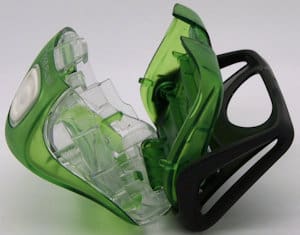A great engineered headlamp product, with the usage of many plastic tricks, a tight assembly, an all-in-one electronic board, and optics, all designed in a small battery-size footprint and withstanding harsh environment.
Although this is not their latest model, as this brand is making improvements years after years for decades, this is a great example for any industry.
Disclaimer: innovation.world has no financial incentive whatsoever, nor any ownership in the product reviewed. Products are chosen based on the only factor of having interesting or original designs to share with other industries. These products are on the market for years; Innovation.world has not and does not disclose any special or confidential information, but only what is visible by dismounting, observation and knowledge from similar technologies. Note however that these designs may be patented by their respective owners.
To the best of our knowledge, this particular product is copyrighted and produced by Petzl.
Design Review
Head strap
The head strap can be completely removed, as this is the typical wear part after years of usage.
Even the shapes of the length adjusting clips have a curved shape for the fingers to grip well. Nice!

Both strap ends have a finishing part (over-molded or clipped ?) to avoid the strap fraying.
From a value analysis of strictly required parts, some of the different pieces of plastic making the adjustment could be removed and still assume the length adaptation function. But the handling would not be so nice and that would create a hanging loop on the back of the head … so possible in some range/brands, but a no-go for any high-level product category.
The main body and its support

Overall, it is a very nice piece of 3D engineering and molding design.
The head support has a curved shape to fit the head curve and the rubber strap passes in such a way that the plastic is almost not in contact with the head, the strap being in between for hourlong contact with the forehead.
Two flexible plastic tongues with indexers, applied on a gear-like shape on the main body ensure a firm holding of the lamp at any angle, without adding additional parts or springs.
A hollowed shape, a bit hidden by the strap both reduces weight but also permits hanging the lamp on a wall.
The main body has one clip on each side to help to open the body to change the battery; those are very very small (more on that hereunder).
Once open, the batteries are accessible. Compared to older or other models, there is no band or other mechanism to remove the batterie easily. With gloves that operation is not so easy, but at least the band is not in the way when closing.
The complete active part block rotates towards the front when opening. This part of the housing is made of two parts of distinctive colors, although it would have been possible to make it out of one depending on how the main top knob is designed or attached.
Electronics and optics sub-assembly

The main sub-assembly comprises the battery block, the PCB, and the front lens clipped plastics
The battery block and the PCB are self-sufficient to be able to activate all light functions. This is likely very handy in production to test the block before further mounting in the main housing.
The 3 LEDs, so as the switch are mounted on the PCB which has 2 pins + 2 opposed clips to hold it. The only separated solderings are the through-holes metal pins forming the battery connectors on the other side. These are possibly hand-soldered. No separate wire in the complete design.
A thin sealing protects the front face of the PCB, the one the more exposed to water, while the back of the battery compartment is not protected (other more specific headlamps have such battery water protection, like models dedicated for speleology, at the cost of a special remote compartment with associated additional wires)
This block is then inserted and maintained in the housing thanks to 4 clips and holds perfectly like that. Nevertheless, 2 additional screws secure that, likely to achieve a huge resistance to external shocks or to maintain integrity even if the body cracks. Electronic
Conclusion
2 thumbs up!
This product is literally constructed around the 3 batteries, thus achieving a very great integration of its components.
Such an integration level is very close to the level achieved in the phone industry.
Both the choice of available functions, as the robust design & its manufacture demonstrate a huge experience in the product and its usage in harsh conditions.
Potential improvments & innovations
This product is clearly already very well thought, with years of continuous improvements both in the end-users features, the robustness & quality, and its production at an optimized cost (you don’t get to such features integration in one go). Nevertheless, can we suggest:
Improvements
Potentially:
- bigger on/off top knob, especially when used with gloves which are typical for these types of applications; from a value analysis, the knob could also be part of the plastic part around to decrease the number of parts. That would be achieved with slimmer thickness and a softer plastic
- we are not a big fan of the cover to main body junction, both from a visual & from a water ingress point of view; maybe a different shape, or a kiss-off, or a slope putting the water out of it
- more possibilities to attach or hang the lamp when not on the head; the current hole, hidden on the strap, does not provide a great position when attached to a nail or hook on the wall on hand inside a tent.
- the clips to open the lamp to change the batteries … so small and so hard to see … nails are required here. Although the battery is not changed continuously and that feature should not be “activate” during normal usage, some designs could be even further improved here. Among others: slightly more accessible, maybe with a recess in front, maybe as part of the other part (…). Currently, it is almost looking like a mold defect which this complete product has none. In general,...
You have read 76% of the article. The rest is for our community. Already a member? Log in
(and also to protect our original content from scraping bots)
Innovation.world community
Login or Register (100% free)
View the rest of this article and all members-only content and tools.
Only real engineers, manufacturers, designers, marketers professionals.
No bot, no hater, no spammer.







































2 thoughts on “Headlamp design review”
Does anyone else think the electronics and optics sub-assembly could influence the weight distribution of the headlamp?
Interesting review, but isnt the head straps durability more critical than design aesthetics? Whats your take on this?